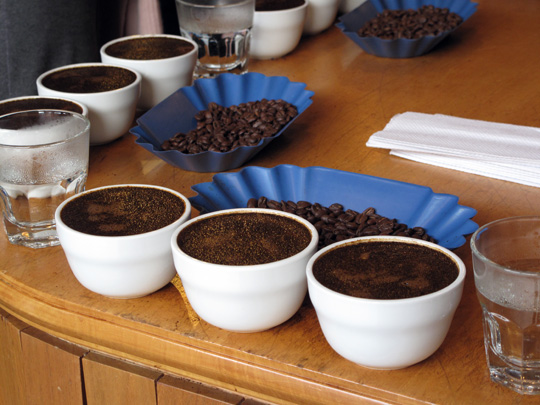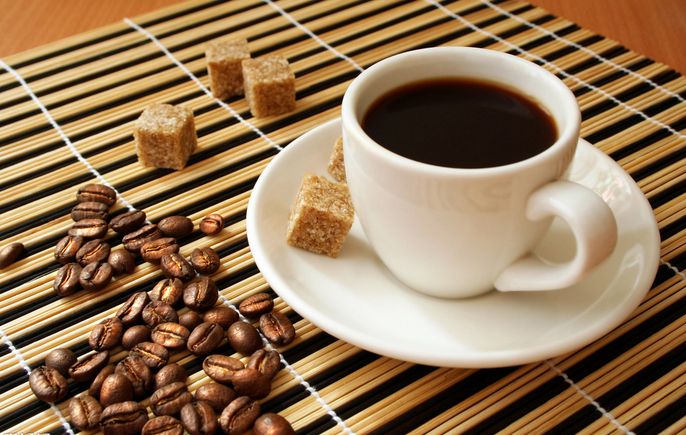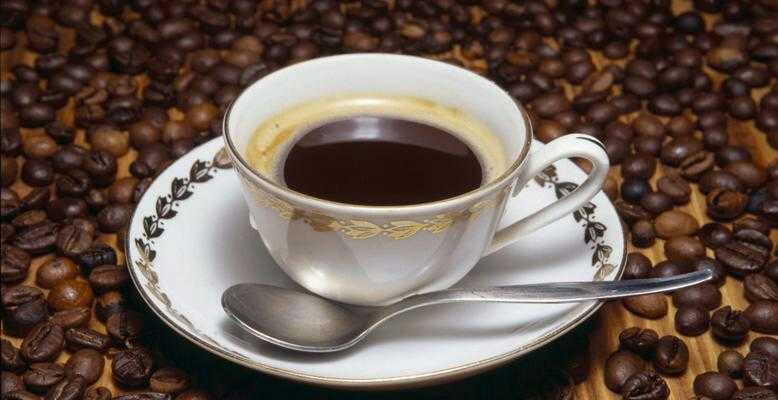How to test coffee cups at home
Follow the caf é (Wechat official account vdailycom) and found that Beautiful Cafe opened a small shop of its own.
Coffee cup testing is a compulsory course for any coffee lover or professional. What is a coffee cup test? Cup testing is a standardized method for testing the quality of coffee. People taste a batch of coffee samples in order to identify the aroma and taste of coffee. Cup testers must strictly follow the standardized scoring system to evaluate the quality of coffee, and after everyone's tasting is completed, cup testers also need to communicate and compare with each other.
Coffee cup testing may be one of the key skills for coffee practitioners. The purpose of the cup test is to help raw bean buyers master and understand the quality of coffee before pricing and restocking, just as tasters test the quality of red wine when choosing red wine in a restaurant.
But at home, our cup testing process does not need to be too rigorous. The purpose of our cup test is not to buy raw beans, but to enjoy the fun of coffee cup test and taste the fresh taste of all kinds of coffee. Cup testing can bring you into a whole new world of coffee, and your understanding of coffee will be improved.

So, how do we test coffee cups at home?
In the home cup test, you need.
The cup test is best done in groups for comparison between different coffees. Here are the appliances and equipment you need for cup testing at home:
At least 2 people, either family, friends, or anyone.
At least 2 freshly roasted coffee, preferably 3-4, the specific quantity is free to choose
A bean grinder. Ensure the uniformity of grinding and the stability of quality to the maximum extent.
A cup, a test bowl. Any small bowl or glass will do.
A large glass, full of water, used to wash spoons, one spoon per person
Empty coffee cups. During the cup test, you need to spit out the coffee you inhale and make sure everyone has a coffee cup to use as a waste jar.
Kettle
An accurate electronic scale
Pen and cup test score table.
About coffee.
First of all, coffee is not recommended for deep roasting, because the deeper it is roasted, the more insipid and uniform the taste of coffee will be, and its unique flavor will be lost.
The ideal coffee should be a single coffee with a roasting date of no more than 2 weeks. You can buy your favorite coffee from the Internet or from a nearby coffee shop.
Tip: for beginners, you can refer to the taste notes given by big brand bakers and compare them with expert opinions after your own cup test to find the gap.
About the location
Cup testing is best carried out with friends or family, so try to choose more spacious places, such as living room, kitchen, etc., the table should be as large as possible, make sure there is room for cups and other utensils, and there is enough space to record.
Preparatory work
After preparing the equipment and location, let's start the preparation for the cup test:
1. Determine the amount of gouache. The recommended powder-to-water ratio is 1:18. Put the coffee beans into the test bowl. Don't grind the coffee first. First, you need to mark different kinds of coffee for recording and comparison.
two。 Boil water. It is best to use fresh filtered water, which may affect the taste of coffee.
3. Grinding. To grind cup by cup, when grinding different kinds of coffee, be sure to clean up the bean grinder in advance, and then grind the next coffee.
4. Smell dry incense. After grinding, before pouring water, let everyone smell the dry aroma of the coffee and record it accordingly.
5. Stop boiling water. The ideal water temperature should be about 202 ℉ (94 ℃). If there is no temperature control condition, when the water is already boiled, it should be left at rest for 25 seconds before starting to pour water. When pouring water, it should start from the coffee that is first ground.
6. Pour water. Make sure all the coffee powder is completely soaked and the water is not poured too fast. Control the amount of water to ensure the accurate proportion of gouache.
7. Time. Start timing when pouring water, and then proceed to the next step when the timer time reaches 4 minutes.
8. Break the shell & pick up the slag. Now it's time to break the shell, when you need to put your nose as close to the cup as possible, use the "shell" of coffee powder floating on the surface under the spoon, and smell the aroma of the coffee. Every cup of coffee needs to be broken, and there are many ways to break it. The method I use is to insert two spoons into the coffee cup, rotate it to both sides, push the coffee powder to the other end of the bowl, and then skim out the coffee grounds.
9. Taste it. Now comes the most exciting step: tasting! It sounds strange to suck the coffee from the spoon into your mouth when tasting, but the aim is to spray the coffee evenly into your tongue and mouth to give you a more comprehensive understanding of the taste of coffee.
10. After each cup of coffee is tasted, insert the spoon into the water and wash it, so as not to affect the taste of the next cup of coffee.
11. As the temperature of the coffee drops, you need to taste the taste characteristics of each coffee after cooling over and over again.
About recording and evaluation
The purpose of the cup test is to test the taste of coffee. It tests people's ability to distinguish and describe each taste.
This is really difficult, especially for beginners, the description of coffee taste is so complicated that it is difficult for people who have just come into contact with the cup test to remember so many professional words. I usually encourage beginners to describe in their own language, and then refer to professional advice to find accurate description words. Here are some of the most commonly used description methods:
Sweet: this may be one of the key criteria to distinguish high-quality coffee from regular coffee. Even sour coffee, as long as it is slightly sweet, you will find the coffee very palatable.
Sour: sour can be the smell of fruit and flowers, or sharp or sour, especially when the coffee is cooled, the sour taste of the coffee will be more fully reflected.
Taste: taste is the texture and thickness of coffee in the mouth. It may be difficult for beginners to judge the taste, but with the accumulation and enrichment of cup testing experience, you will be more accurate in judging the taste of coffee.
Aftertaste: the afterscent is the final taste of coffee after tasting. Good coffee should have a pure, sweet aftertaste and last for more than 15 seconds.
Important Notice :
前街咖啡 FrontStreet Coffee has moved to new addredd:
FrontStreet Coffee Address: 315,Donghua East Road,GuangZhou
Tel:020 38364473
- Prev

Coffee now single cup drink takes the lead in the new situation of health and integration.
The latest National Nutrition Plan (2017-2030) was released on July 19th, which mentioned that after the initial realization of scientific and standardized nutrition, in view of the further improvement of national living standards, on the basis of scientific nutrition, development with the help of cloud computing, big data and the Internet to promote the development of health industry and nutrition industry, provide modern accurate, scientific and convenient nutrition health, and achieve nutrition health.
- Next

Caffeine can improve memory and enhance its activity.
Follow caffeine comments (Wechat official account vdailycom) found that Beautiful Cafe opened its own shop in Hokkaido University in Japan. A team of researchers recently confirmed that the mechanism by which nerve cells in the brain hippocampus, which is responsible for memory and learning, forms memory is the same as the contraction of cardiac muscle cells, while eating caffeinated foods such as coffee can enhance their activities and improve memory. People used to be
Related
- Beginners will see the "Coffee pull flower" guide!
- What is the difference between ice blog purified milk and ordinary milk coffee?
- Why is the Philippines the largest producer of crops in Liberia?
- For coffee extraction, should the fine powder be retained?
- How does extracted espresso fill pressed powder? How much strength does it take to press the powder?
- How to make jasmine cold extract coffee? Is the jasmine + latte good?
- Will this little toy really make the coffee taste better? How does Lily Drip affect coffee extraction?
- Will the action of slapping the filter cup also affect coffee extraction?
- What's the difference between powder-to-water ratio and powder-to-liquid ratio?
- What is the Ethiopian local species? What does it have to do with Heirloom native species?

